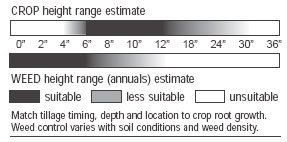Agronomic Row Crops
Maximum-Residue Cultivator
Intended for no-till or ridge-till fields, untilled residue equivalent to a corn crop of more than 160 bushels/acre, in moderate to heavy soils with occasional 500-pound rocks.

Overview: These heavyweight units are built with the industry's top strength, soil-penetrating ability, and fore-to-aft as well as vertical clearance. Some can handle the residue of 250-bushel-per-acre corn, and others can subsoil between the rows. Weight may exceed 2 tons, so match the unit carefully with your tractor's hydraulic capacity, tire ballast and auxiliary weights.

Design Features: Massive 7" x 7" toolbars; sweeps up to 28" wide; wider and stronger parallel linkage (pivoting connections between the sweep gangs and the cultivator toolbar, flexing so that each gang can follow the surface contour but remain rigid side-to-side); and gauge wheels to control depth. Shanks are usually curved chisel-plow type standards or rigid vertical shanks, with some of the latter braced with welded steel plates. Adjustments include sweep angle to control penetration, disk-hiller spacing and angle (to direct soil flow), and coulter depth.
An auto-reset (trip-and-return spring) mechanism on some models allows a shank to extend backward over an obstruction when it exceeds the trip pressure. This option protects the tool while it maintains a uniform depth setting more consistently than a spring-cushioning shank.
Model for comparison: 15', rigid frame for 6 rows on 30" centers (6R30)
Includes toolbar; high-clearance shanks equipped with auto-reset springs; three-piece sweeps; and disk hillers, gauge wheels and residue-cutting coulters on each gang.
Rec. PTO HP: 90 to 120
Speed: 5 to 8 mph
List price: $9,210 to $13,580
Width range (all makers/all models): 8' to 44'
Sources: 1, 2, 5, 21, 37, 38, 43, 46, 50, 62, 73, 74, 78, 83
Farmers: Bennett, Erisman, Kenagy, Hattaway, Thompson
TIP: To increase a tractor's ability to handle a heavier cultivator, try lift-assist wheels (page 26). To handle more compacted soil conditions, increase front-weighting or tractor tire ballast, as manufacturer specifications allow.
